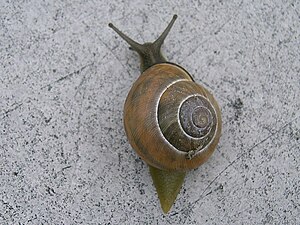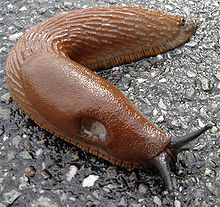Land snails
| Land snails | ||||||||||||
|---|---|---|---|---|---|---|---|---|---|---|---|---|

Grove cepaea ( Cepaea nemoralis ) |
||||||||||||
| Systematics | ||||||||||||
|
||||||||||||
| Scientific name | ||||||||||||
| Stylommatophora | ||||||||||||
| A. Schmidt , 1855 |
The land snails (Stylommatophora, Greek for 'stalk eyes') are representatives of the lung snails that live permanently on land . From the freshwater aquatic snails , which have only one pair of antennae, they differ conspicuously by four (two pairs) handle-shaped antennae, of which the rear, longer pair has the eyes at the tip.
Breathing takes place through the lung cavities, the walls of which are very vascular. Land snails need a special water balance to protect them from dehydration. They produce large amounts of mucus that protects against excessive evaporation. In addition, a housing often provides additional protection. Nudibranchs, in which the shell is reduced, avoid exposure to the sun. But land snails can survive for a few days even with high water loss (50–80%). Some xerophilic species with thick limestone shells are even desert dwellers.
construction
casing
Like most snails, most land snails also have a shell. In addition to the evaporation protection already mentioned, this offers the snails protection from danger and the cold. In the event of danger, the land snail retreats into its housing. Since it does not have a lid, the opening is closed with a jacket bead. During longer periods of drought or cold, the snails close their shells with an epiphragma (lime seal). The snail shell corresponds to an external skeleton. It is already formed in the egg during development and consists of three layers, the outer conchiolin layer , followed by the lime and the third, inner mother-of-pearl layer . The lime layer is formed by special glands that are located on the edge of the mantle (regulate growth in size) and on the surface (regulate growth in thickness ). The housing is installed in the form of calcium carbonate . Their shell is curled up in a screw-like manner and rarely receded. In the last turn of the snail shell, especially in the opening, there are often teeth and various depressions.
Nudibranchs

In nudibranchs, the shell has receded and is often still rudimentary . With them, the visceral sac is reduced, since the organs normally located in it are secondarily included again in the dorsal part of the head foot (cephalopodium). Like the respiratory opening, the genital opening in nudibranchs is always on the right.
Above all, the loss of the shell gave the slugs greater mobility.
Reproduction

Land snails, unlike most other snails, are hermaphrodites . They lay up to 70 eggs, from which the young snails hatch after a few weeks.
The act of mating, using the Roman snail as an example: First, the snails touch each other with their antennae. Then they climb up each other. In order to stimulate the other person, the snails shoot a 5-10 mm long lime stiletto into their sole. The actual act of mating: the animal acting as a male injects a packet of semen into the sexual opening of the other. Now the snails separate again. Double fertilization rarely takes place. Then egg cells are produced in the hermaphroditic gland of the “female” (the “males” produce their semen there) and sent towards the semen packet. Now the eggs will be fertilized. A few days later the snail digs a hole in the earth and lays the eggs there. Small snails hatch from these eggs 2–6 weeks later. You have a transparent house because you have not yet been able to accumulate lime. They slip out of the cave and start to eat. The animals are sexually mature after about 3 years.
Paleontology and evolution
In addition to a few rather uncertain older finds at the end of the Paleozoic , which perhaps only represented external convergence formations, as well as assumed real Stylommatophora at the end of the Jurassic period, there are certain fossil representatives of various modern families of the Stylommatophora from the Upper Cretaceous ( Coniacium , approx. 88 million years ago) ). These are obviously members of the Streptaxidae , Camaenidae and Helminthoglyptidae families . In the next stage (the Santonium , about 85 million years ago) the families Subulinidae and Plectopylidae follow .
Systematics
According to recent molecular biological studies by Wade, Mordan & Naggs (2006), the Stylommatophora are monophyletic. According to Bouchet & Rocroi (2005), they contain the following superfamilies and families:
- Suborder land snails (Stylommatophora) A. Schmidt, 1855
- Superfamily Succineoidea Beck, 1837 (= Heterurethra)
- Family Amber Snails (Succineidae) Beck, 1837
- Superfamily Athoracophoroidea P. Fischer, 1883 (= Tracheopulmonata)
- Family Athoracophoridae P. Fischer, 1883
- Superfamily Partuloidea Pilsbry, 1900
- Family Partulidae Pilsbry, 1900
- Family Draparnaudiidae Solem, 1962
- Superfamily Achatinelloidea Gulick, 1873
- Family Achatinellidae Gulick, 1873
- Superfamily Cochlicopoidea Pilsbry, 1900
- Family of smooth snails (Cochlicopidae pilsbry, 1900)
- Amastridae family Pilsbry, 1910
- Superfamily Enoidea Woodward, 1903
- Family glutton worm (Enidae Woodward, 1903)
- Subfamily Buliminusinae Kobelt, 1880
- Family Cerastidae Wenz, 1923
- Family glutton worm (Enidae Woodward, 1903)
- Superfamily Pupilloidea Turton, 1831
- Doll snail family (Pupillidae turton, 1831)
- Family Argnidae Hudec, 1965
- Family grain snails (Chondrinidae Steenberg, 1925)
- Family † Cylinderellinidae Zilch, 1959
- Lauriidae Steenberg family , 1925
- Family cone snails (Orculidae pilsbry, 1918)
- Family slugs (Pleurodiscidae Wenz, 1923)
- Family pyramid snails (Pyramidulidae Kennard & Woodward, 1914)
- Family Spelaeoconchidae Wagner, 1928
- Family Spelaeodiscidae Steenberg, 1925
- Family Strobilopsidae Wenz, 1915
- Family grass snails (Valloniidae Morse, 1864)
- Diaper snail family (Vertiginidae Fitzinger, 1833)
- Superfamily Clausilioidea Gray, 1855
- Door snails family (Clausiliidae Gray, 1855)
- Family † Anadromidae Wenz, 1940
- Family † Filholidae Wenz, 1923
- Family † Palaeostoidae Nordsieck, 1986
- Superfamily Orthalicoidea Albers-Martens, 1860
- Family Orthalicidae Albers-Martens, 1860
- Family Cerionidae Pilsbry, 1901
- Family Coelociontidae Iredale, 1937
- Family † Grangerellidae Russell, 1931
- Family Megaspiridae Pilsbry, 1904
- Family Placostylidae Pilsbry, 1946
- Family Urocoptidae Pilsbry, 1898
- Superfamily Achatinoidea Swainson, 1840
- Family of African giant snails Achatinidae Swainson, 1840
- Family ground snails (Cecilioididae Mörch, 1864 or Ferussaciidae Bourguignat, 1883)
- Family Micractaeonidae Schileyko, 1999
- Ahlenschnecken family (Subulinidae Fischer & Crosse, 1877)
- Superfamily Aillyoidea Baker, 1960
- Aillyidae Baker family , 1960
- Superfamily Testacelloidea Gray, 1840
- Backpack snail family (Testacellidae Gray, 1840)
- Family Oleacinidae H. & A. Adams, 1855
- Family Spiraxidae Baker, 1939
- Superfamily Papillodermatoidea Wiktor, Martin & Castillejo, 1990
- Family Papillodermatidae Wiktor, Martin & Castillejo, 1990
- Superfamily Streptaxoidea J.E. Gray , 1806
- Family Streptaxidae J.E. Gray , 1806
- Superfamily Rhytidoidea Pilsbry, 1893
- Family Rhytididae Pilsbry, 1893
- Family Chlamydephoridae Cockerell, 1935
- Family Haplotrematidae Baker, 1925
- Family Scolodontidae Baker, 1925
- Superfamily Acavoidea Pilsbry, 1895
- Family Acavidae Pilsbry, 1895
- Family Caryodidae Connolly, 1915
- Family Dorcasiidae Connolly, 1915
- Family Macrocyclidae Thiele, 1926
- Megomphicidae Baker family , 1930
- Family Strophocheilidae Pilsbry, 1902
- Superfamily Plectopyloidea Moellendorf, 1900
- Family Plectopylidae Moellendorf, 1900
- Family Corillidae Pilsbry, 1905
- Sculptariidae Degner family , 1923
- Superfamily Punctoidea Morse, 1864
- Family punctidae (Punctidae Morse, 1864)
- Family † Anastomopsidae Nordsieck, 1986
- Family Charopidae Hutton, 1884
- Family Cystopeltidae Cockerell, 1891
- Family bowl snails (Patulidae Tryon, 1866 = Discidae Thiele, 1931)
- Family Endodontidae Pilsbry, 1895
- Family Helicodiscidae Baker, 1927
- Family Oreohelicidae Pilsbry, 1939
- Family Thyrophorellidae Girard, 1895
- Superfamily Sagdoidea Pilsbry, 1895
- Sagdidae family Pilsbry, 1895
- Superfamily Helicoidea Rafinesque , 1815
- Schnirkelschnecken family (Helicidae Rafinesque , 1815)
- Family shrub snails (Bradybaenidae Pilsbry, 1934)
- Family Camaenidae Pilsbry, 1895
- Family Cepolidae Ihering, 1909 (name is invalid)
- Schileyko family Cochlicellidae , 1972
- Family Elonidae Gittenberger, 1977
- Family Epiphragmophoridae Hoffmann, 1928
- Family Halolimnohelicidae Nordsieck, 1986
- Riemenschnecken family (Helicodontidae Kobelt, 1904)
- Family Helminthoglyptidae Pilsbry, 1939
- Family Humboldtianidae Pilsbry, 1939
- Family leaf snails (Hygromiidae tryon, 1866)
- Tribus heather snails (Helicellini Ihering, 1909)
- Family Monadeniidae Nordsieck, 1987
- Family Pleurodontidae Ihering, 1912
- Family Polygyridae Pilsbry, 1894
- Family Sphincterochilidae Zilch, 1960
- Family Thysanophoridae Nordsieck, 1987
- Superfamily Xanthonychoidea Strebel & Pfeffer, 1879
- Family Xanthonychidae Strebel & Pfeffer, 1879
- Family Echinichidae Thompson & Naranjo-García, 2012
- Superfamily Gastrodontoidea Tryon, 1866
- Family Staffordiidae Thiele , 1931
- Family dagger snails (Gastrodontidae Tryon, 1866)
- Family gloss snails (Oxychilidae Hesse, 1927)
- Subfamily Daudebardien (Daudebardiinae, Kobelt, 1906)
- Crystal snail family (Pristilomatidae Cockerell, 1891)
- Superfamily Trochomorphoidea Möllendorff, 1890
- Chronidae Thiele family , 1931
- Kegelchen family (Euconulidae Baker, 1928)
- Trochomorphidae Möllendorff family , 1890
- Superfamily Parmacelloidea Fischer, 1856
- Family parmacellidae Parmacellidae Fischer, 1856
- Kielschnegel family (Milacidae Ellis, 1926)
- Family Trigonochlamydidae Hesse, 1882
- Superfamily Zonitoidea Mörch, 1864
- Giant snail family (Zonitidae Mörch, 1864)
- Superfamily Helicarionoidea Bourguignat, 1877
- Family Helicarionidae Bourguignat, 1877
- Family Ariophantidae Godwin-Austen, 1888
- Family Urocyclidae Simroth, 1889
- Superfamily Limacoidea Rafinesque-Schmaltz, 1815
- Schnegel family (Limacidae Rafinesque-Schmaltz, 1815)
- Family field snails (Agriolimacidae Wagner, 1935)
- Wormsail family (Boettgerillidae van Goethem, 1972)
- Family glass snails (Vitrinidae Fitzinger, 1833)
- Superfamily Arionoidea Gray, 1840
- Slugs family (Arionidae Gray, 1840)
- Family Anadenidae Pilsbry, 1948
- Family Ariolimacidae Pilsbry & Vanatta, 1898
- Family Binneyidae Cockerell, 1891
- Family Oopeltidae Cockerell, 1891
- Family Philomycidae Gray, 1847
- Superfamily Succineoidea Beck, 1837 (= Heterurethra)
Individual evidence
- ^ Noel Morris & John Taylor: Global events and biotic interactions as controls on the evolution of gastropods. In: Stephen J. Culver, Peter F. Rawson: Biotic response to global change: The last 145 million years . Cambridge University Press (2000)
- ^ MJ Benton (Ed.): The Fossil Record 2. Chapman & Hall, London 1993.
- ^ A b Fred G. Thompson, Edna Naranjo-García: Echinichidae, a new family of dart-bearing helicoid slugs from Mexico, with the description of a new genus and three new species (Gastropoda: Pulmonata: Xanthonychoidea) . Archives for Molluscology, 141 (2): 197-208. doi : 10.1127 / arch.moll / 1869-0963 / 141 / 197-208 . Preview (PDF; 385 kB)
literature
- Philippe Bouchet, Jean-Pierre Rocroi: Part 2. Working classification of the Gastropoda. In: Malacologia. , Volume 47, Ann Arbor 2005 ISSN 0076-2997 , pp. 239-283.
- Christopher M. Wade, Peter B. Mordan, Fred Naggs: Evolutionary relationships among the Pulmonate land snails and slugs (Pulmonata, Stylommatophora). In: Biological Journal of the Linnean Society. Volume 87, Oxford 2006, ISSN 0024-4066 , pp. 593-610.
- Wilfried Westheide, Reinhard Rieger (Hrsg.): Special zoology. Volume 1. Spectrum Academic Publishing House, 2003, ISBN 3-8274-1482-2 .
